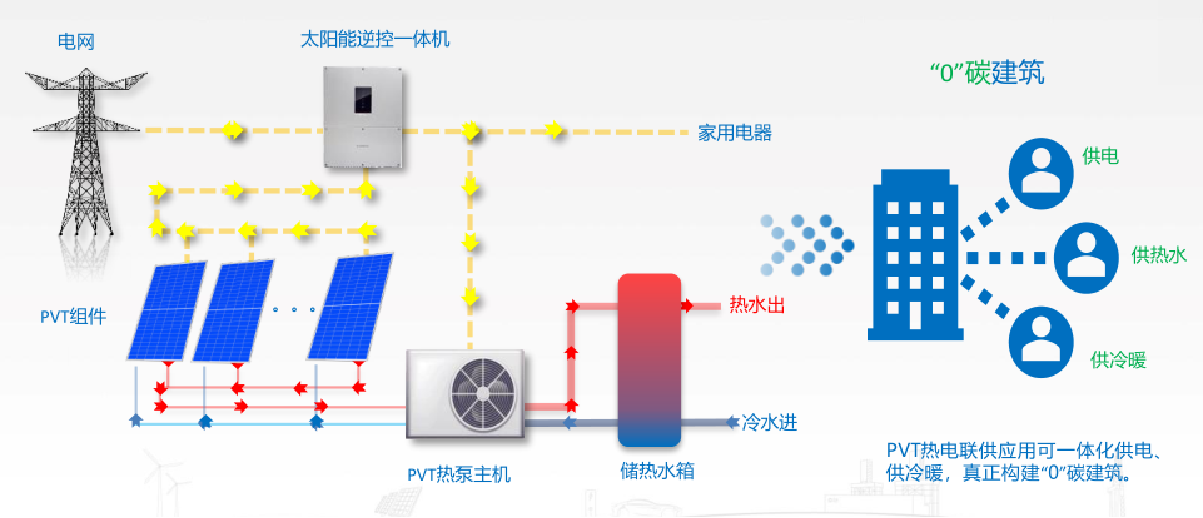Photovoltaic-Thermal Heat Pump System (PVT) Detailed Analysis
What Is a Photovoltaic-Thermal Heat Pump System (PVT)?
The Photovoltaic-Thermal Heat Pump System (PVT) integrates photovoltaic (PV) power generation, thermal energy collection, and heat pump technology. By adding a thermal recovery module to PV panels, it captures waste heat generated during electricity production. This heat is upgraded via a heat pump to meet building electricity, space heating, and domestic hot water demands. A water circle water tank supply optimizes heat storage and distribution, while integration with a high temp heating system ensures compatibility with demanding applications like industrial processes. The system’s synergy with technologies such as the Cool energy heat pump and inverter pool heat pump further enhances efficiency, making PVT a cornerstone of sustainable energy solutions.

Components of a PVT System
(1) Photovoltaic Module (PV)
The PV module converts sunlight into electricity, while its thermal collector captures waste heat (30–60°C). This heat is channeled into a water circle water tank supply for storage or directly used for low-temperature applications. When paired with a high temp heating system, excess heat can be upgraded to meet industrial or residential demands.
(2) Thermal Collector Module
Liquid-based collectors transfer heat to a water circle water tank supply, stabilizing energy availability. This thermal buffer supports both direct use (e.g., domestic hot water) and serves as a low-temperature source for the heatpump, improving its coefficient of performance (COP). For specialized needs, such as pool heating, an inverter pool heat pump dynamically adjusts output, reducing energy waste.
(3) Heat Pump System
The heatpump is central to upgrading recovered heat. Key types include:
-
Air/Water/Ground Source Heat Pumps: Utilize ambient air, water, or ground heat.
-
Cool Energy Heat Pump: Optimizes thermal upgrading with minimal electricity consumption.
-
Inverter Pool Heat Pump: Provides variable-speed heating for pools, lowering operational costs.
These systems rely on PV-generated electricity, ensuring sustainability. The water circle water tank supply acts as a thermal reservoir, while the high temp heating system enables high-grade heat delivery for industrial use.
(4) Intelligent Control System

This system prioritizes energy flow between the PV array, heatpump, water circle water tank supply, and high temp heating system. It adjusts operations based on solar input, demand, and storage levels, ensuring seamless integration of subsystems like the Cool energy heat pump and inverter pool heat pump.
Main Advantages
-
Efficiency: Combined PV-thermal recovery achieves >60% solar utilization. The water circle water tank supply and high temp heating system maximize energy reuse.
-
Sustainability: Reduced fossil fuel reliance lowers carbon emissions. The Cool energy heat pump minimizes power use during heat upgrading.
-
Cost-Effectiveness: Low operating costs, with ROI in 5–7 years. The inverter pool heat pump cuts pool heating expenses by 30–50%.
-
Versatility: Suitable for homes, industries, and recreational facilities. The heatpump adapts to diverse needs, from residential HVAC to industrial high temp heating systems
Application Scenarios
-
Residential: PVT provides electricity, floor heating, and hot water via a water circle water tank supply. The high temp heating system ensures winter comfort.
-
Commercial: Offices use PVT for HVAC and lighting, supported by Cool energy heat pumps for efficient climate control.
-
Industrial: Food processing leverages recovered heat stored in a water circle water tank supply, with high temp heating systems for sterilization.
-
Recreational: The inverter pool heat pump delivers precise, energy-efficient pool heating.
Challenges and Future Trends
-
Costs: High upfront investment for components like the heatpump and water circle water tank supply. Innovations in Cool energy heat pump designs aim to reduce costs.
-
Policy: Subsidies for high temp heating systems and PVT integration could boost adoption.
-
Research: Hybrid systems combining PVT with hydrogen storage and advanced heatpump tech (e.g., inverter pool heat pump) promise 24/7 energy supply.
Conclusion
The PVT system, enhanced by a water circle water tank supply, high temp heating system, Cool energy heat pump, and inverter pool heat pump, represents a transformative renewable energy solution. By optimizing solar utilization and integrating adaptive heatpump technologies, it addresses diverse energy needs while advancing global carbon neutrality goals.



